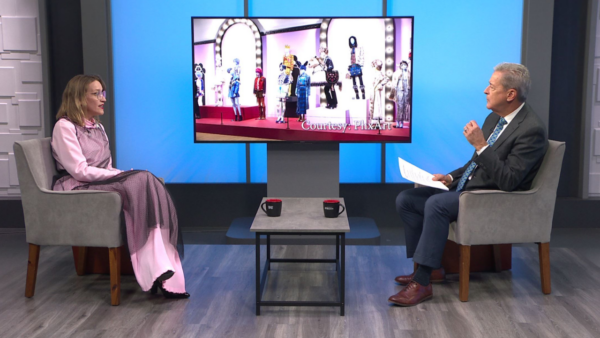AAA has put out the second phase of a study that looks at the impact of voice-activated technology on driving. AAA and researchers at the University of Utah compared distraction levels of six different voice-activated in-car technologies. Stephanie Dembowski of AAA Arizona will talk about the results.
Ted Simons: AAA has released the second phase of a study that looks at the impact of voice-activated technology on driving. Here now to talk about the results of the research is Stephanie Dembowski of AAA Arizona. Good to have you here. This is the second phase of a study. What exactly are you looking at?
Stephanie Dembowski: Right. So as a safety advocate, last year we took a look at different distracting behaviors in the vehicle. We conducted a study on different behaviors and rated them on a one to five scale. A one is the least distracting, and then a five is extremely distracting and in that study, we found that voice activated features, so speech to text type features, around the cell phone, that rated at three. So we wanted to take a closer look at that for the second phase of the study and that's what we did. We evaluated the infotainment feature, the manufacturers that had the largest share, the most cars on the road with the systems in them and rated them. We had drivers hooked up to all kinds of devices, monitoring brainwaves and checking their eye movements to see reaction times and missed visual cues and the overall results are that hands-free are not risk-free.
Ted Simons: Because you're doing something other than driving. What exactly is that? Is that an earpiece in my cell phone listening to music or talking on the phone? Define it for us.
Stephanie Dembowski: When in a vehicle you can push a button and say call home or find gas station. You're talking to your vehicle or a system on your cell phone, trying to get it to give you some sort of information.
Ted Simons: So even though you're doing that and your eyes are on the road, the fact you're simply doing that, that's a distraction?
Stephanie Dembowski: Exactly, exactly.
Ted Simons: What about things like Siri? You've got your iPhone and doing the whole Siri thing.
Stephanie Dembowski: We took a look at Siri, too, and on the scale, she ranked a four. So the vehicle systems we had them do two simple tasks. It was tuning to a radio station, and then voice dialing. So change to whatever station and call home or stuff like that. Siri we had her do a little bit more complex tasks because she can or is supposed to, so she was doing things like composing e-mails, updating social media statuses and things like that and it was the iOS 7 version which has been upgraded. She was rated the most distracting of anything, of any in-car system.
Ted Simons: I can understand that because she's getting things wrong all the time. You ask to call A. and which A. do you want? As far as these technologies are concerned now, the car makers that did the best, the ones that could use some help as far as less distraction?
Stephanie Dembowski: So what our study found, we looked at six manufacturers. It was Toyota, Hyundai, Chevy, Mercedes, Chrysler and Ford. Toyota ranked the best, their system was a 1.7, just about as distracting as listening to the radio. Their system performed very well. The most distracting was Chevy's system that was a 3.7. And Ford was just behind it at 3.0.
Ted Simons: What made Ford and Chevy's more distracting?
Stephanie Dembowski: The complexity of the system, just like you mentioned, talking to Siri, she's getting things wrong, when you have to repeat yourself or if there's a specific format you have to use to get the system to understand you, maybe it's pulling up a list, you're saying call mom and it pulls up all seven of mom's phone numbers and you need to look at a screen. The more complex and the less accurate the system was, the longer the interaction time and the more distracting it was.
Ted Simons: Is the fact that some of these things make, you need to look at a screen in order to do x, y, z, if you keep your eyes on the road and talk, is that better?
Stephanie Dembowski: It really varies. I think that the most important thing is that we remind drivers that just because we can talk to our cars doesn't mean we should be. And it's really creating kind of a false sense of security for drivers because they're getting it through their heads that they need their eyes on the road and their hands on the wheel and they're doing that and they think it must be safe, but unfortunately, this study is showing that just because your hands are on the wheel and your eyes on the road, your mind is someplace else and that's not safe, either.
Ted Simons: I remember when the idea of talking on the phone because your phone's down there, that that would be better than holding the phone up here. You're saying that even the headphone and the microphone, in many cases is better than some of these voice activated technologies.
Stephanie Dembowski: Exactly, yeah. Some of those just talking on the phone ranked about a two where these voice activated features just the mental workload is about a three.
Ted Simons: What do we take from these findings? Will there be a phase three?
Stephanie Dembowski: They're already underway. We hope to see that early in 2015 and I believe they'll be taking an even more in-depth look at these voice activated systems and how we can improve them and the study, we don't want to point fingers at Chevy or whoever's system scored worst. It's to start the conversation on we need to take a look at those systems and how safe they are for drivers. They're being released on the roads at crazy speeds. Just because they're in the cars doesn't mean they're safe. We want automakers to make them safer. The convenience is great. But then we also want to remind drivers that our main priority in that car is driving and to drive safely.
Ted Simons: Yeah, all right, very interesting stuff, good to have you here, thanks for joining us.
Stephanie Dembowski: Thank you.
Stephanie Dembowski:AAA Arizona;























